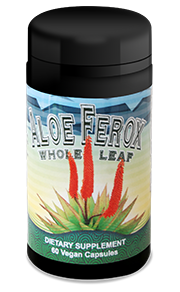Aloe Ferox Nutrient Profile
 Amino Acids – Aloe Ferox contains 34 amino acids, including 7 of the 8 essential ones such as Alanine, Anserine, Arginine, Aspartic Acid, Asparagine, Citrulline, Cystine, Ethanolamine, Glutamic Acid, Glutamine, Glycine, Histidine, Hydroxyproline, Isoleucine, Leucine, Lysine, Methionine, Phenylalanine, Phosphoserine, Proline, Serine, Threonine, Tyrosine, Ureum, Valine, Methylhistidine and Aminobutyric acid.
Amino Acids – Aloe Ferox contains 34 amino acids, including 7 of the 8 essential ones such as Alanine, Anserine, Arginine, Aspartic Acid, Asparagine, Citrulline, Cystine, Ethanolamine, Glutamic Acid, Glutamine, Glycine, Histidine, Hydroxyproline, Isoleucine, Leucine, Lysine, Methionine, Phenylalanine, Phosphoserine, Proline, Serine, Threonine, Tyrosine, Ureum, Valine, Methylhistidine and Aminobutyric acid.
Amino Acids are the building materials of the body needed for growth and repair. Amino acids are used to make hormones, enzymes, antibodies and neurotransmitters.
Chlorophyll – Nature’s way of protecting against radiation while helping to produce energy. The electron flow produced by chlorophyll pigments is used to shuttle H+ ions in the production of cellular ATP (cell energy). The body also uses Chlorophyll for blood purification and production of red blood cells in bone marrow.
Glycoproteins serve diverse and essential roles in human physiology. Over the past decade, scientists and physicians around the world have been studying the remarkable benefits of glyco-nutrients on human health, especially in the immune system. Many of the key molecules involved in the immune response, such as immunoglobulins, are glycoproteins. Glycoproteins have structural functions and are a constituent of healthy cell walls and connective tissue such as collagen. Glycoproteins are also found in gastrointestinal mucous secretions and are abundant in the blood plasma. Glycoproteins play an important part in hormone function. The action of hormones depends on the initial binding of the hormone to a protein receptor molecule. This molecule is a glycoprotein. Glycoproteins appear in nearly every biological process studied.
Glycosides – Saponins, Phenols, Anthraquinones: Aloin, Aloe-emodin, Aloinoside A/B, 5-hydroxyaloin, Chrysophanol, Aloesin, Aloe resin A/C, Iso-aloeresin A, Furoaloesone, Chrysophanic Acid, Cinnamic acid, Emodin, Coumarins, and Resistannols all enable the Aloe Ferox plant to be an extraordinary boost for the immune system.
Minerals – Aloe Ferox contains Calcium, Magnesium, Phosphorus, Potassium, Sulphur, Boron, Chromium, Cobalt, Copper, Iron, Manganese, Nickel, Selenium, Strontium, Tin, Vanadium, and Zinc. All vitamins and enzymes require minerals for activity. All physiological processes depend on the presence of minerals which are commonly lacking in our food. Minerals in their organic state (present in plant life) function more effectively in the body compared to common dietary supplements that use non-live source ingredients. Whole-body pH balance depends on minerals, specifically in their live-source, enzyme form with naturally occurring trace mineral activators.
Monosaccharides – Rhamnose, Arabinos, Xylose, Mannose, Galactose, and Glucose are known to be of significant benefit in immune support, and wound healing, used in the production of cytokines, support proper blood sugar metabolism and joint tissue health.
Polysaccharides – Arabinogalactans, rhamnogalacturonans, glucomannoglycans, and hemicellusoses are used by the body to support immune processes, blood sugar metabolism, and heart health. Polysaccharides also function as pre-biotics in the digestive tract promoting a healthy gut ecology.
Sterols – Sitosterol, Cholesterol, and Lupeol, naturally occurring plant sterols, have a long history of research documenting both safety and efficacy in promoting heart health by positively affecting cholesterol.
Fiber
Insoluble Fiber: Cellulose and Lignins promotes stool bulk, peristalsis, improved defense against immune challenges to the digestive tract, and soothe the mucous membrane of the bowel.
Soluble Fiber: Arabinogalactan, Rhamnogalacturonan, and Mucilage have great benefit in sugar metabolism, blood pressure, and cardiac health.
Vitamins – Aloe Ferox contains vitamins in their enzyme form: A, C, E, B1, B2, B3, B6, B12, Folic Acid, and Cholineall of which have a wide function in human physiology and wellbeing. Together with minerals and trace elements, vitamins function as catalysts for all enzyme processes. "The spark of life"

